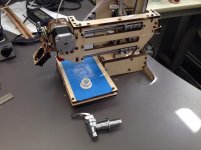You know tbj1, when I close my eyes and ears to the snarly tone, that was actually a very useful and informative post.
I was not aware of the speed advantage of a system that uses less or no support material; of course it makes perfect sense as soon as you point it out and why it's so.
Similarly, I've been using annoying workarounds to cover the whole printable area of the ABS mounting platforms and agree with you that it's expensive and wasteful to follow the Stratasys recommendation and replace the build platform after every print.
I concur fully that the price of the spools is just short of breathtaking; perhaps "usurious", or "blatant theft" is appropriate.
I've never used a "budget" class machine and I know nothing about their abilities.
It appears you have extensive experience; I'd certainly appreciate learning some of what you've discovered, and I'm sure many others would too.
So by all means, if you're minded to, send pictures, show us what you mean when you compare the output of one machine against another.
That's all hugely useful information and we'll be in your debt if you take the time to educate us, and become an ambassador for the technology.
There are plenty of us who can see the usefulness of 3D printing, but can't justify splashing out 25 grand for a new Uprint Plus or equivalent.
Certainly had I known what you're alluding to here, I'd have taken a much closer look before I wrote the cheque; but like many, I was unimpressed by the YouTube videos of inexpensive kit printers I'd seen, and dismissed them all without looking closely at any of them.
For that oversight I paid a pretty stiff premium; my used machine cost me twelve grand.
It's OK; I can make money with it and it's useful to me, but it's not as good as I'd like and if I could have achieved substantially the same outcome for a tenth of the cost, I'd be miles ahead.
So by all means, tell us of your experiences; I for one would love to know.
Cheers
Marcus
Implant Mechanix – Design & Innovation - home
Vancouver Wire EDM -- Wire EDM Machining







